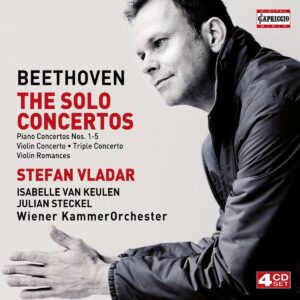For his second Beethoven concerto cycle, Stefan Vladar joins the rank of pianists who have recorded these works directing from the piano. In some instances, Vladar’s solo contributions have gained profile and definition since his earlier Naxos traversals with Barry Wordsworth on the podium: compare his more incisive accentuation this time around in the Second concerto’s scampering finale, the stronger sense of line in the Third concerto’s Largo, and the additional freedom and fancifulness evident in the cadenzas. However, this is essentially “Beethoven lite”.
The problems mainly lie with the Vienna Chamber Ensemble’s small-scaled dynamic range and threadbare strings that reduce the heft and thrust of Beethoven’s ritornellos to dollhouse dimensions, chock-full of those overly tapered feminine endings that HIP maestros adore. Take the Fourth concerto’s central movement for example. While Vladar is right in pursuing a true Andante con moto, there’s a clipped fussiness to the “sempre staccato” articulation absent from the more tonally focused and resplendent Vienna Philharmonic strings as led from the keyboard by Rudolf Buchbinder.
And for all of their excess reverberation, the Naxos recordings boast less skewed balances. In the new Third Concerto’s Rondo, to cite one instance, the solo oboe vaguely wanders in and out of the mix, whereas on Naxos it’s exactly where it should be within the orchestral image. In the “Emperor” Concerto outer movements Vladar’s fingerwork has gained gauntness and drive while losing its erstwhile nuance and breadth.
Balances are less of a problem in the clear and ebullient Triple Concerto with cellist Julian Steckel and violinist Isabelle van Keulen, although the soloists’ more traditional use of expressive vibrato sounds alien in context to the orchestra’s minimum vibrato aesthetic. The same holds true in the Violin Concerto, yet here Vladar’s full time attention to conducting results in a shapelier, more dynamic orchestral framework in support of his eloquent, warm-toned soloist.
Keulen plays Christian Tetzlaff’s unabashedly fun cadenza, which features a prominent timpani part. In the piano concertos, Vladar plays the longest of Beethoven’s first-movement cadenzas for No. 1, plus the common first-movement cadenza option for No. 4 that pianists such as Schnabel, Arrau, and Fleisher favored.
































